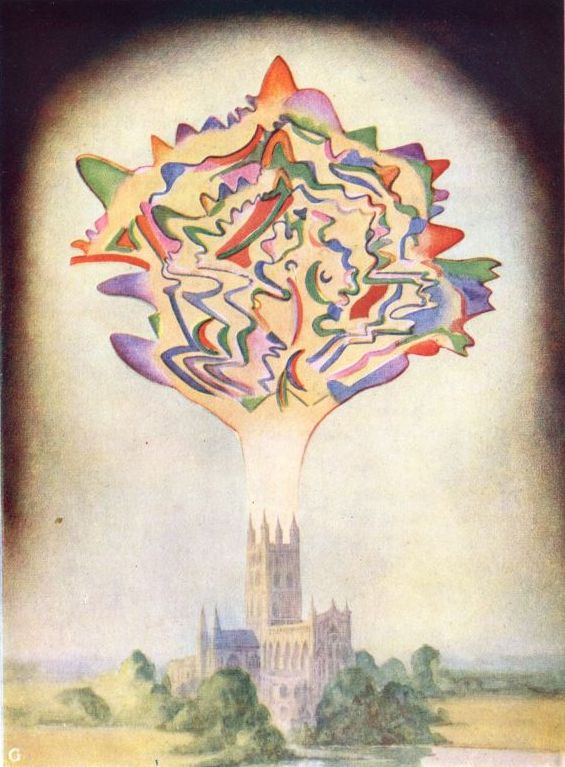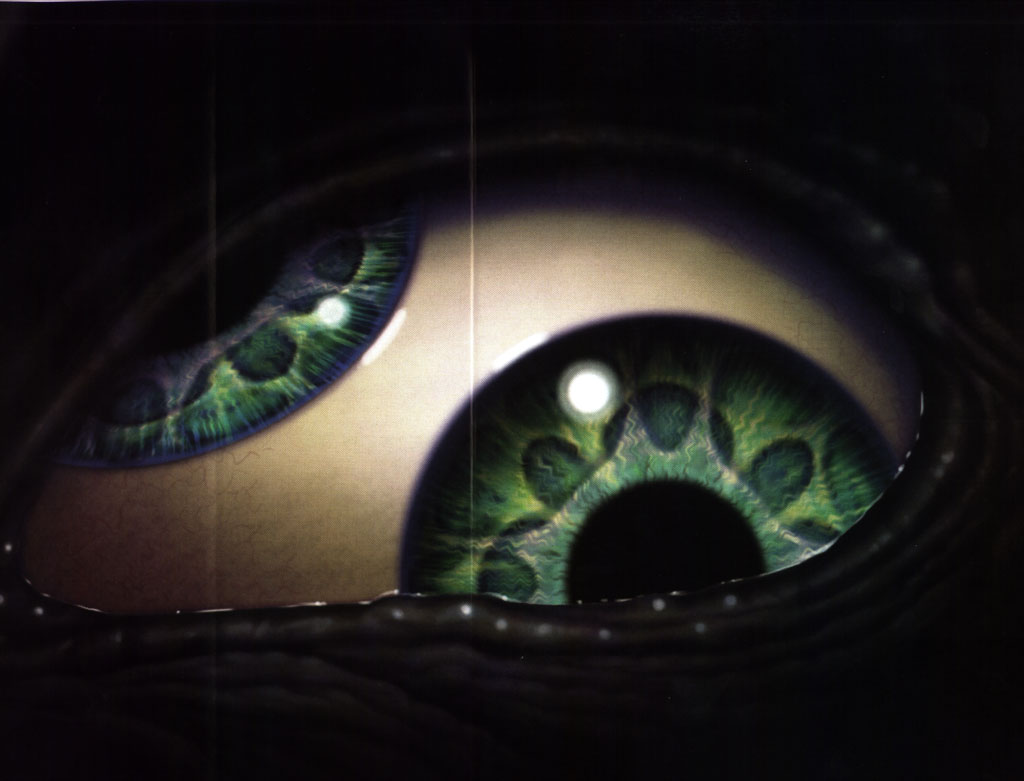I like the occult, ever since I was a kid. That's why I loved Occult Adventures in Pathfinder, as well as more occult stuff in VtM and other occult books. That's why I put them into my settings and games all the time.
The setting I run is called Anacaona and in it, magic infuses the lands. Not like Eberron, where magic is stable and industrialized. It's random and dangerous and requires a gifted and disciplined mind to wield. There are spirits that are disembodied creatures of ethereal matter that flow freely through our world and the world beyond. They are sapient like us and while they may have alien minds, capricious emotions, or unfathomable agenda, they are still existing creatures.
But then there are thoughtforms.
These are metaphysical elementals and psychic emanations. These are ideas, emotions, and thoughts that dance in the pale starlight of the Astral Plane, but have a pseudo-existence anywhere else. They are hallucinations that simply exist in the mind, more so than the creatures of the Plane of Dreams. If mortal beings acted like evolution, then thoughtforms could be everyone's microbial ancestors. They have the facsimile of life, like a virus or a prion, but on their own, they simply are. And like a virus, they can be dangerous to us mortals. More on that later down the line.
It's unknown what created what. Did thoughtforms give us mortals the ideas and inspiration we use every day, or did we create them with our minds? Or some combination of the two? What is true is that thoughtforms 'exist' on their own and can also be created by mortals. Occultists in Anacaona believe that some thoughtforms can manifest in our realm of existence, but can be dangerous if not controlled by a powerful, disciplined mind. Mystics and psychics seems to have the best ability to control them, but also suffer the worst effects when they lose control. Psychics in particular act as great vectors of thoughtform epidemics, which can be more dangerous than a simple disease.
Thoughts are infectious. A thoughtform that manifests into our plane begins seeking out intelligent and sapient minds to infect and grow. The more complex and intelligent the mind, the better the conditions for infection, growth, and reproduction. And they spread quickly once in a population, passing on to their future generations like a meme. Some thoughtforms are fairly benign. For all anyone knows, they could be infected and never know. Some occultists wonder if all mortals are essentially carriers and diseased, and that in itself creates different cultures and beliefs. There's a scary thought.
| From Alex Gray |
Some thoughtforms though are dangerous. They infect your mind and change you, slowly. Every thought you have begins to transform into the current thoughtform's thought, and you slowly become completely obsessed with that thought. A thoughtform about the color green would make its victims completely obsessed with green and do anything in their power to hoard green items. This is how many occultists know someone may be infected by a thoughtform; manic obsessive habits over a singular item at the cost of everything, including their own survival. And the difference between your standard insanity and a thoughtform infection is that it spreads.
It's spreads easily. All it takes is to think about it. If you're around a person infected, you are now infected. You start becoming puzzled as to why the person is obsessed with green, and eventually, you become obsessed with the color green. Suddenly, within weeks, your whole village is filled with green-obsessed people, killing each other over anything that is green. Which can actually be the inherent weakness to a thoughtform. Because people are prone to violence very quickly, it can't spread faster than it kills. A chilling relief I suppose.
 |
| Okay, I may be a little obsessed with Alex Gray and Tool |
When a thoughtform does keep enough people alive and infested, it blooms. It saps all of their infecteds' mental energy, making them comatose, and becomes something more than an idea. It becomes an image, an icon, a hallucination. It becomes a tulpa. A disembodied sentient thought that can now interact meaningfully with people around it. It exists, and yet doesn't. It now has the reasoning capabilities of a spirit or mortal, but still cannot exist without someone thinking about it. And so it continues to infect people, hoping to become something more.
A tulpa works a little different than a normal thoughtform, since it is stronger and can be created by a powerful mind. Tulpas are less like viruses and more like parasites. They attach to one host as the primary host, then infect everyone else around them. Curing the main host destroys the tulpa, but unlike regular old thoughtforms, tulpas can exert powerful control over their infected and even their host. This works like possession in a game, but the host gets a bonus if they created the tulpa.
Most tulpas become sociopathic and insane, trying to become real at any cost. Some occultists believe that a powerful mind, like that of a psychic, can help the tulpa become real, and many tulpas seek a psychic to do such a thing. Perhaps it is true, or perhaps not. But be wary when helping a tulpa, because they are absolutely unstable and can turn on you if they think you aren't helping enough.
How does one defeat a thoughtform or cure an infection?
One of the best ways is simply forgetting about them. Induced amnesia is a common way, whether through magic (memory rewriting), surgery, or blunt force trauma. Mental training and discipline to fight them back is another one, but that only keeps them at bay and doesn't cure your memetic infection. Hypnotic suggestion and creating a mental block can quarantine the infection in your mind and you'll be safe until your next infection. Creating a mental block requires being hypnotised (a Diplomacy or Persuasion check against your Wisdom score) and at least three, one hour-long hypnosis sessions. Hallucinogens can help amplify the process, but makes it a bit more risky. Delving into the dreams of a host infected by a tulpa is the best way to destroy the thoughtform or tulpa. With special magic and hallucinogens, you can become psychonauts and explore yours or your friend's mind and cure them. For curing a mob of people infected with a thoughtform, luring them back into the Astral Plane with rituals is surefire. Finding these rituals is a quest onto itself though.
Types of Thoughtforms
Spells are a type of thoughtform, brought into existence by wielders of arcane magic. Wizards bring in a thought from the Astral Plane, nurture it with spellbook preparation, then release it as a spell to affect the Material Plane. Reading a spellbook is actually a way for the wizard or any arcane caster to prepare a spell without the thought taking over their mind. All arcane spells still have a chance to go haywire, but it is usually temporary and doesn't infect or destroy the caster. A prepared arcane caster that doesn't read their spellbook at the start of the day can still cast spells, but has a 50% chance of manifesting a living spell. This chance goes down 2% per level in your arcane class.
Atavisms are thoughtforms of raw emotion. Hate, love, sorrow, joy, etc. They are pure embodiments of that emotion and anyone that is infected by one acts upon it in the extreme. A hate atavism will drive people to extreme violence. A love atavism would probably be like the school dance episode of Rick and Morty. Not good.
Logists are simple thoughts and ideas that float in the Astral Plane. The most varied, they can really be of anything. The idea of a beautiful sunset. The thought of justice. The sounds of a lovely symphony. Any thought, rational or irrational, is a logist.
An archetype is a bit more complex than most thoughtforms. They are a combination of ideas and thoughts combined to form a pastiche of something. The archetypical cultural hero, kind princess, scoundrel with a heart of gold, or other urban legends and cultural heroes. While they may seem complex like a tulpa, archetypes still have no intelligence of their own. They simply change slightly because of a person's expectations of the archetype. So the archetypical cultural hero would look completely different to two people from two different kingdoms, but still be the same thoughtform.
Tulpas are advanced thoughtforms, given sentience. Whether they are created by a powerful and creative mind, or came about from a previous thoughtform pandemic, tulpas are smarter, stronger, and a bit more unhinged than their counterparts. They are now aware that their existence lies with people believing in them, and if everyone forgets them, then they cease to exist. All tulpas make a bond with a host or their creator. Some stay friendly with their host so that they can exist longer. Children make great hosts and this is where imaginary friends come from. Other continue their infectious ways and spread to others, using their host as a carrier. That way, if that host dies, the tulpa can simply move on to another infected. Some say there are rituals that can allow a tulpa to become truly real and mortal.
Dimyalos are thoughtforms created by two (though sometimes more) creatures that aren't sentient but have great psychic potential. When the creatures come together, they create this intelligence. A dimyalo doesn't infect other hosts because it is dependant on these specific creatures, but they become fiercely protective over their hosts. They spread their influence more by combining more creatures of those types that can make more dimyalos.
Egregores are powerful, almost like lords over other thoughtforms. These are usually created by occultists of similar minds, though it is rare for one to form from a group with similar mindset. A group must be synchronous with each other, mentally and spiritually, to create an egregore. The creature is similar to a hive mind, but is greater than the sum of its parts. It knows everything its creators know and has great psychic potential. Egregores don't need to infect other minds to stay alive, though many will try and get more converts to add to its collection. It exists as long as its creators are safe, and disrupting any of them can weaken the egregore. If an egregore gathers enough minds and exists for a long enough time, they can transcend the need of its creators and move on, leaving behind the occultists as mindless husks. Many form an egregore to attain enlightenment through each other, while other use it to gain greater psychic power.
How Thoughtforms Work
For the basic thoughtforms, I want it to be like a disease. I like the rules in Lamentations of the Flame Princess for disease. Simple and concise. For the dimyalo, tulpa, and egregore, these would be actual monsters, similar to ghosts, but focused on keeping people remembering them. I like that concept of a creature that only exists if you believe in them. It can be a bit scary if you think about it, and makes one think about their own mortality and how people will remember them after they are gone. Or even if they do remember them.
In a future blog post, I plan on doing this. Probably more doable on Tuesday because of my work schedule.


No comments:
Post a Comment